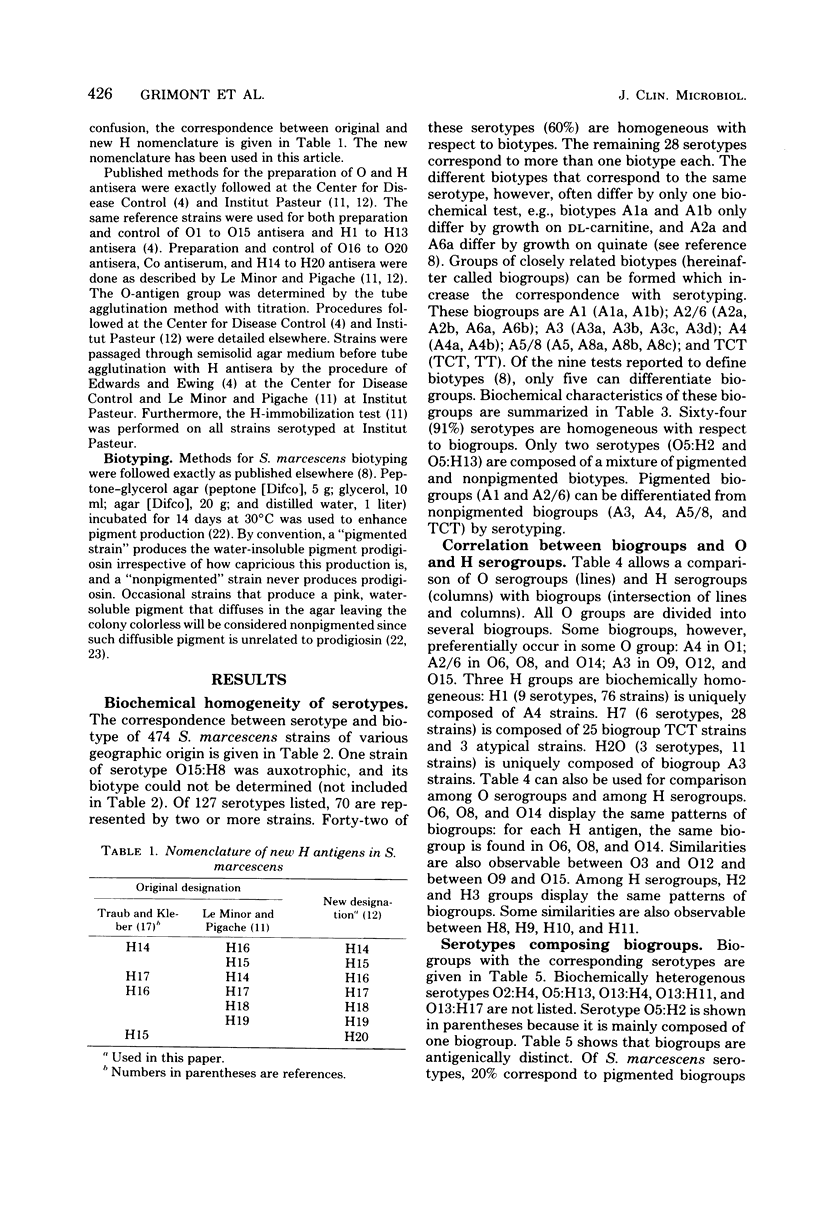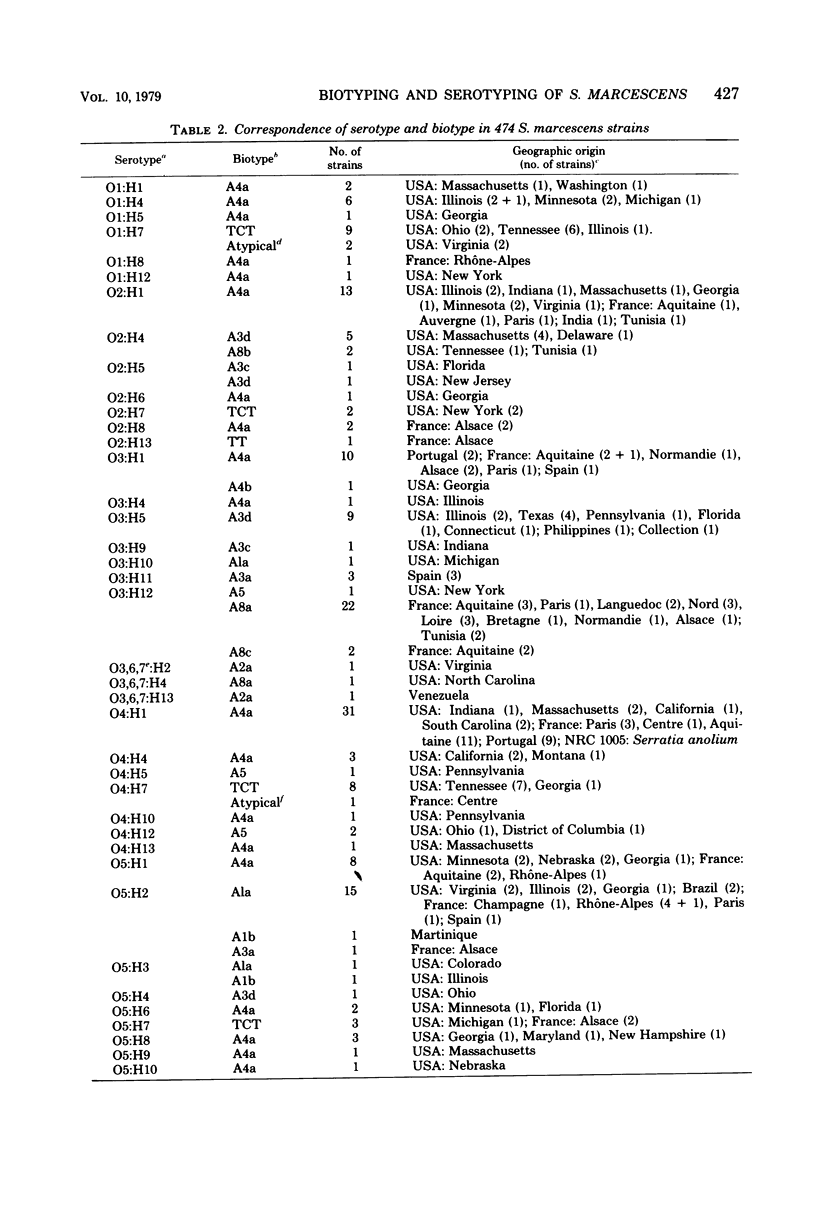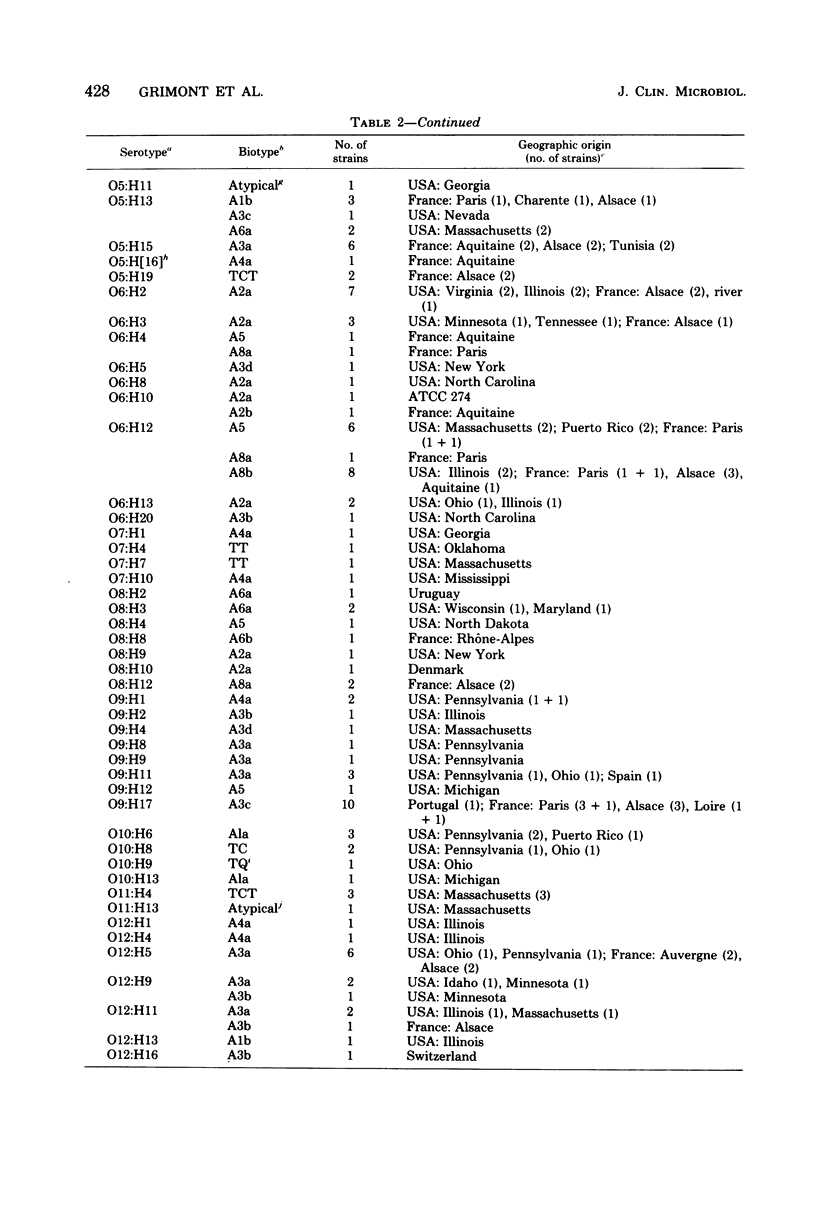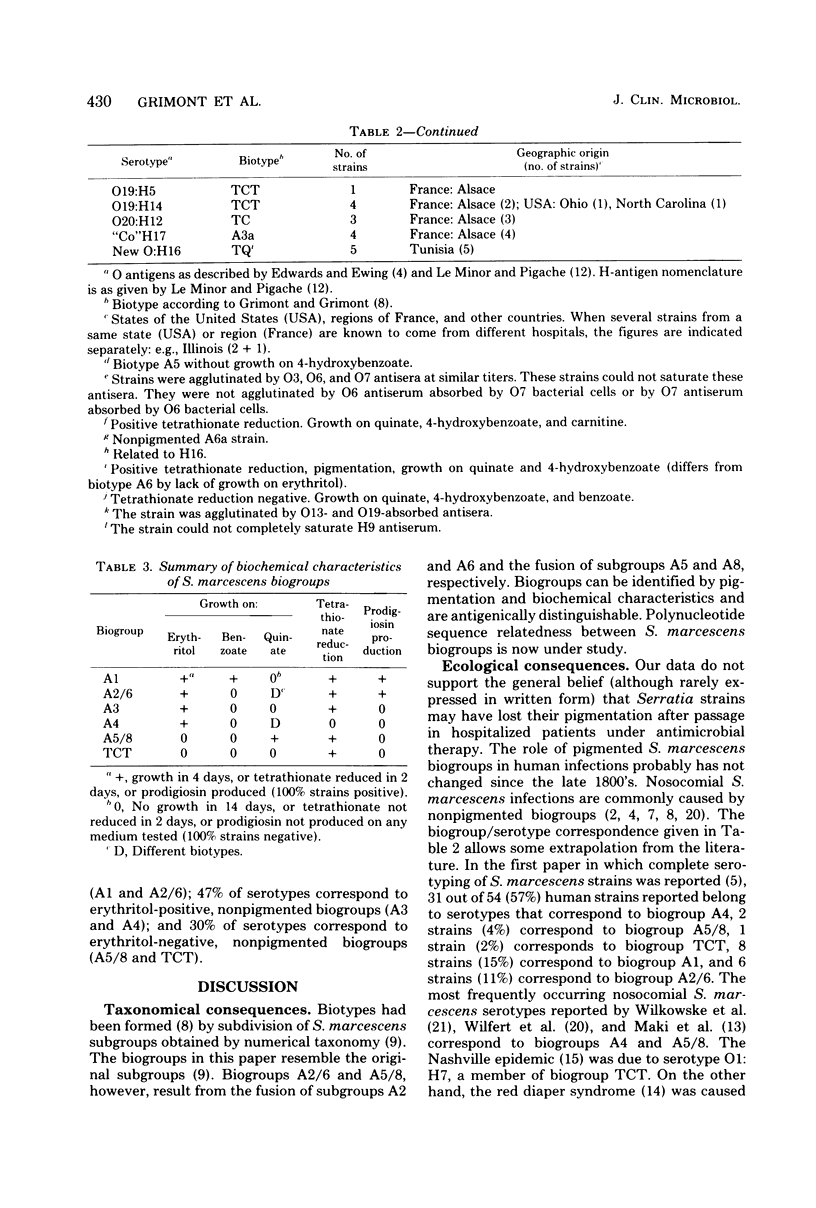Abstract
The correspondence between complete serotype and biotype (P.A.D. Grimont and F. Grimont, J. Clin. Microbiol. 8:73-83, 1978) of 474 Serratia marcescens strains was studied. Of 127 serotypes, 70 were represented by two or more strains of the same serotype belonged to one biotype. However, for 91% of serotypes, strains of the same serotype belonged to one biogroup--i.e., a group of closely related biotypes. Biogroups are A1 (A1a, A1b); A2/6 (A2a, A2b, A6a, A6b); A3 (A3a, A3b, A3c, A3d); A4 (A4a, A4b); A5/8 (A5, A8a, A8b, A8c); and TCT (TCT, TT). Only two serotypes were composed of a mixture of pigmented and nonpigmented biogroups. Pigmented biogroups (A1 and A2/6) were otherwise differentiated from nonpigmented biogroups (A3, A4, A5/8, and TCT) by serotyping. Some biogroups preferentially occurred in some O serogroups: A4 in 01; A2/6 in O6, O8, and O14; and A3 in O9, O12, and O15. Three H serogroups were found to be biochemically homogeneous: H1, H7, and H20 were respectively and uniquely composed of biogroups A4, TCT, and A3. A square matrix of O versus H serogroups, with the corresponding biogroup for each O X H combination, was used for comparisons between O groups and between H groups. Identical patterns of biogroups were shown by serogroups O6, O8, and O14. Taxonomical, ecological, and practical consequences of these findings are discussed.
Full text
PDF







Selected References
These references are in PubMed. This may not be the complete list of references from this article.
- Altemeier W. A., Culbertson W. R., Fullen W. D., McDonough J. J. Serratia marcescens septicemia. A new threat in surgery. Arch Surg. 1969 Aug;99(2):232–238. doi: 10.1001/archsurg.1969.01340140104015. [DOI] [PubMed] [Google Scholar]
- Clayton E., Von Graevenitz A. Nonpigmented Serratia marcescens. JAMA. 1966 Sep 26;197(13):1059–1064. [PubMed] [Google Scholar]
- DAVIS B. R., WOODWARD J. M. Some relationships of the somatic antigens of a group of Serratia marcescens cultures. Can J Microbiol. 1957 Jun;3(4):591–597. doi: 10.1139/m57-064. [DOI] [PubMed] [Google Scholar]
- Farmer J. J., 3rd, Davis B. R., Hickman F. W., Presley D. B., Bodey G. P., Negut M., Bobo R. A. Detection of Serratia outbreaks in hospital. Lancet. 1976 Aug 28;2(7983):455–459. doi: 10.1016/s0140-6736(76)92539-3. [DOI] [PubMed] [Google Scholar]
- Grimont P. A., Grimont F. Biotyping of Serratia marcescens and its use in epidemiological studies. J Clin Microbiol. 1978 Jul;8(1):73–83. doi: 10.1128/jcm.8.1.73-83.1978. [DOI] [PMC free article] [PubMed] [Google Scholar]
- Grimont P. A., Grimont F., De Rosnay H. L. Taxonomy of the genus Serratia. J Gen Microbiol. 1977 Jan;98(1):39–66. doi: 10.1099/00221287-98-1-39. [DOI] [PubMed] [Google Scholar]
- Le Minor S., Pigache F. Etude antigénique de souches de Serratia marcescens isolées en France. I--Antigènes H: individualisation de six nouveaux facteurs H. Ann Microbiol (Paris) 1977 Aug-Sep;128(2):207–214. [PubMed] [Google Scholar]
- Le Minor S., Pigache F. Etude antigénique de souches de Serratia marcescens isolées en France. II.--Caractérisation des antigènes O et individualisation de 5 nouveaux facteurs, fréquence des sérotypes et désignation des nouveaux facteurs H. Ann Microbiol (Paris) 1978 Oct;129 B(3):407–423. [PubMed] [Google Scholar]
- Maki D. G., Hennekens C. G., Phillips C. W., Shaw W. V., Bennett J. V. Nosocomial urinary tract infection with Serratia marcescens: an epidemiologic study. J Infect Dis. 1973 Nov;128(5):579–587. doi: 10.1093/infdis/128.5.579. [DOI] [PubMed] [Google Scholar]
- McCormack R. C., Kunin C. M. Control of a single source nursery epidemic due to Serratia marcescens. Pediatrics. 1966 May;37(5):750–755. [PubMed] [Google Scholar]
- SEDLAK J., DLABAC V., MOTLIKOVA M. THE TAXONOMY OF THE SERRATIA GENUS. J Hyg Epidemiol Microbiol Immunol. 1965;9:45–53. [PubMed] [Google Scholar]
- Schaberg D. R., Alford R. H., Anderson R., Farmer J. J., 3rd, Melly M. A., Schaffner W. An outbreak of nosocomial infection due to multiply resistant Serratia marcescens: evidence of interhospital spread. J Infect Dis. 1976 Aug;134(2):181–188. doi: 10.1093/infdis/134.2.181. [DOI] [PubMed] [Google Scholar]
- Traub W. H., Kleber I. Serotyping of Serratia marcescens: determination of serogroup (O) antigens and serological cross-reactions. Zentralbl Bakteriol Orig A. 1978 Jan;240(1):30–56. [PubMed] [Google Scholar]
- Traub W. H., Kleber I. Serotyping of Serratia marcescens: evaluation of Le Minor's H-immobilization test and description of three new flagellar H antigens. J Clin Microbiol. 1977 Feb;5(2):115–121. doi: 10.1128/jcm.5.2.115-121.1977. [DOI] [PMC free article] [PubMed] [Google Scholar]
- WILLIAMS R. P., TAYLOR W. W., HAWKINS D., Jr, ROTH I. L. A water-soluble, diffusible pigment produced by a strain of Serratia marcescens (Chromobacterium prodigiosum). Nature. 1958 Oct 11;182(4641):1028–1029. doi: 10.1038/1821028a0. [DOI] [PubMed] [Google Scholar]
- Wilfert J. N., Barrett F. F., Ewing W. H., Finland M., Kass E. H. Serratia marcescens: biochemical, serological, and epidemiological characteristics and antibiotic susceptibility of strains isolated at Boston City Hospital. Appl Microbiol. 1970 Feb;19(2):345–352. doi: 10.1128/am.19.2.345-352.1970. [DOI] [PMC free article] [PubMed] [Google Scholar]
- Wilkowske C. J., Washington J. A., 2nd, Martin W. J., Ritts R. E., Jr Serratia marcescens. Biochemical characteristics, antibiotic susceptibility patterns, and clinical significance. JAMA. 1970 Dec 21;214(12):2157–2162. doi: 10.1001/jama.214.12.2157. [DOI] [PubMed] [Google Scholar]
- von Graevenitz A. The role of opportunistic bacteria in human disease. Annu Rev Microbiol. 1977;31:447–471. doi: 10.1146/annurev.mi.31.100177.002311. [DOI] [PubMed] [Google Scholar]


